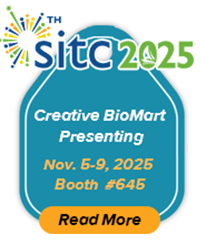| Species : |
Human |
| Source : |
HEK293 |
| Tag : |
Fc |
| Protein Length : |
1-123 a.a. |
| Description : |
Activin A receptor, type I, Fc Chimera (also known as ACVR1 or ALK-2) is an activin type I receptor. The activin type I receptors transducer signals for a variety of members of the transforming growth factor (TGF) beta superfamily of ligands. This family of cytokine and hormones include activin, anti-mϋlle rian hormone (AMH), bone morphogenetic proteins (BMPs) and nodal. Despite the large amount of processes that these ligands regulate, they all operate through essentially the same pathway: A ligand binds to a type II receptor, which recruits and trans-phosphorylates a type I receptor. |
| Amino Acid Sequence : |
MEDEKPKVNPKLYMCVCEGLSCGNEDHCEGQQCFSSLSINDGFHVYQKGCFQVYEQGKMTCKTPPSPGQAVECCQGDWCNRNITAQLPTKGKSFPGTQNFHLEGSSNTKVDKKVEPKSCDKTHTCPPCPAPELLGGPSVFLFPPKPKDTLMISRTPEVTCVVVDVSHEDPEVKFNWYVDGVEVHNAKTKPREEQYNSTYRVVSVLTVLHQDWLNGKEYKCKVSNKALPAPIEKTISKAKGQPREPQVYTLPPSRDELTKNQVSLTCLVKGFYPSDIAVEWESNGQPENNYKTTPPVLDSDGSFFLYSKLTVDKSRWQQGNVFSCSVMHEALHNHYTQKSLSLSPGK. |
| Molecular Mass : |
Under reducing conditions Activin A Receptor, Type I, Fc Chimera migrates as a broad band between 40 and 48 kDa on SDS-PAGE due to post-translational modifications, in particular glycosylation. |
| PI : |
Activin A Receptor, Type I, Fc Chimera separates into a number of glycoforms with an observed pI between 5.5 and 8.5 on 2D PAGE due to post-translational modifications, in particular glycosylation. |
| % Carbohydrate : |
Purified Activin A Receptor, Type I, Fc Chimera consists of 3-20% carbohydrate by weight. |
| Glycosylation : |
Activin A Receptor, Type I, Fc Chimera contains N-linked oligosaccharides and may contain O-linked oligosaccharides. |
| Purity : |
>95%, as determined by SDS-PAGE and visualized by Coomassie Brilliant Blue. |
| Formulation : |
When reconstituted in 0.5 ml sterile phosphate-buffered saline, the solution will contain 1% human serum albumin (HSA) and 10% trehalose. |
| Reconstitution : |
It is recommended that 0.5 ml of sterile phosphate-buffered saline be added to the vial. |
| Storage : |
Lyophilized products should be stored at 2 to 8°C. Following reconstitution short-term storage at 4°C is recommended, with longer-term storage in aliquots at -18 to -20°C. Repeated freeze thawing is not recommended. |



